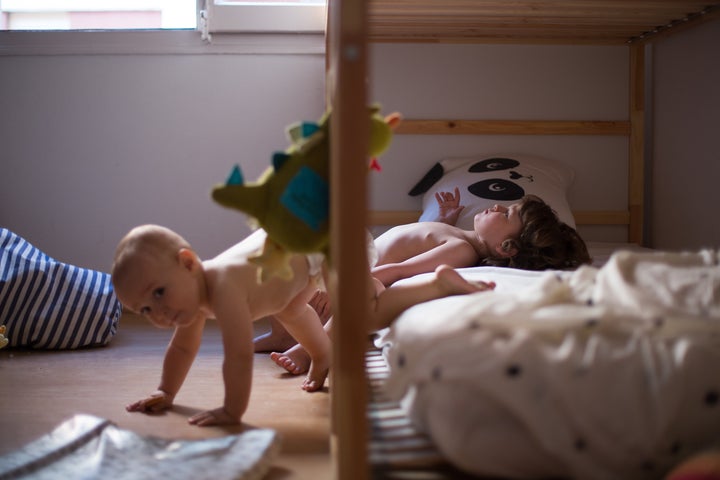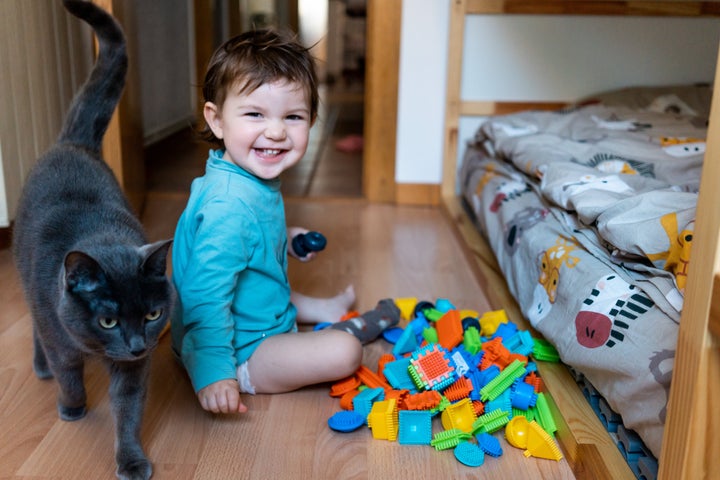Some parents are ditching the crib in favor of beds that kids can safely get in and out of even before they’ve started walking.
If you’ve seen the word “Montessori” used recently on social media, you might be led to believe that it’s a style of home decor for children: lots of wholesome-looking wooden toys, a color scheme of shades with names like “dune” and “oatmeal,” and a minimalist aesthetic.
In fact, Montessori is an educational philosophy that takes its name from Italian physician Maria Montessori. Observing that children seemed to learn best when they were teaching themselves, Montessori gave her young pupils access to classroom materials and permission to follow their own interests in the child care center that she opened in 1907. Visitors found this self-directed style of learning so effective that other Montessori-style schools opened throughout Western Europe over the next few years. The first in the U.S. opened in 1911 in Tarrytown, New York, and today, you can find Montessori schools serving preschoolers and elementary-aged children throughout all 50 states.
According to the American Montessori Society, a Montessori classroom is “designed to create natural opportunities for independence, citizenship and accountability.” Students select activities that interest them and move at their own pace. In a preschool classroom, you might find some children building with blocks while others explore the sand table, paint using easels adjusted to their height or prepare a snack. Kid-sized furniture and features like low sinks allow children to function independently in the classroom.
What does this all have to do with beds? Students don’t sleep overnight at preschool, so bedroom furniture has never been a feature of Montessori classrooms. But parents have extended the Montessori method into their homes, setting up spaces where children have open access and can practice independence.
What is a “Montessori bed”?
In children’s bedrooms, independence means having a bed that your child can safely get in and out of on their own. This means not using a crib. While you can find cozy and whimsical house-shaped wooden “Montessori beds” online, “a mattress on the floor or positioned on slats ticks the Montessori check boxes just as well,” Louise Herbert, a lactation consultant and pediatric sleep specialist, told HuffPost.
The idea is that the child can get themselves into and out of bed without help, and that if they do roll off, they won’t be harmed.

Why do parents choose a Montessori bed?
Having a bed they can climb into and out of promotes the “Montessori principle of independence,” Anitra Jackson, a former Montessori educator who is also a mom, told HuffPost.
“Followers of Montessori principles tend to opt for such a bed for their children, as the lack of restrictions and the low profile give more autonomy to little ones at bedtime and through the night,” said Herbert.
In addition to aligning with Montessori philosophy, there are other advantages to consider. One is cost. You could move your baby from their bedside bassinet or co-sleeper onto a Montessori bed without ever purchasing a crib. Depending on how tall your child is, and what size mattress you begin with, the Montessori bed might last them well into elementary school.
“Floor beds also typically create an inviting space, where it’s easy to play or read stories together during the daytime, which leads to really positive associations and familiarity,” said Herbert, potentially making bedtime less fraught.
If you’re nursing or snuggling your child to sleep, a floor bed might make it easier for you to slip away once they’re snoozing. “Having the option to feed, comfort and soothe your child in their sleep space, without having to carefully negotiate a crib transfer, can feel like gold dust at 2 a.m. when you’re ready to get back to sleep,” said Herbert. If you think you may be spending a significant amount of time there, you can also use a mattress long enough and wide enough to comfortably accommodate both of you.
Lola Sánchez Liste is a pediatric sleep consultant and founder of Rockin’Blinks. She told HuffPost that some parents like the idea of a floor bed because they find the image of their child contained in a crib somewhat alarming. “Some parents will tell me, ‘I feel that when my child is the crib, he’s trapped.’”
Sánchez Liste advises parents to make decisions that feel right for their family, but also to stick to their plans and maintain clear boundaries. “What I always tell them is to choose something and commit to it,” she said. If you say your child has to sleep in their own bed, but then sometimes let them sleep in yours, for example, that doesn’t send a clear message to your child. You can decide to return them to their bed every time they wake and climb out, and even lie beside them until they fall back to sleep, but you need to stick to your word and do the same thing every time. “Consistency is the key with children,” said Sánchez Liste.
This commitment begins before your child hits the mattress: “A regular bedtime routine helps as well,” said Jackson. If you are following the same pattern every night (put on pajamas, brush teeth, dim the lights, read stories, etc.), your child is more likely to fall asleep without a struggle — regardless of what type of bed you choose.

What are the drawbacks?
The big advantage of the floor bed is that kids can get in and out on their own — and the primary disadvantage is definitely that getting out part.
Safety is the No. 1 concern. In the first year, that means reducing the risk of SIDS by placing a baby on their back to sleep on a firm mattress without bedding, pillows or other potential suffocation hazards. As soon as they’re mobile, this means the whole bedroom has to meet safety precautions.
“It’s absolutely possible to meet the criteria for safe sleep, but it’s really important to think of the whole area that baby has access to as the ’sleep space,’” Herbert said. Child-proofing the bedroom means covering all outlets, securing loose cords out of baby’s reach, and ensuring that there is nothing a child can climb onto or potentially pull down on top of them — basically, consider the baby’s bedroom a giant playpen.
Sánchez Liste says that safety with a floor bed really comes down to common sense. “Is the child going to be so independent that they might wake up at 3 a.m. and walk around the house, having access to rooms that might not be very safe for a young toddler to explore?”
If you don’t want to keep the door shut, or you’re afraid that your child will open it on their own, you can put a baby gate in the doorway to their room to keep them safely in place.
You may have to put some extra effort into keeping the floor area around their bed free from dust or other allergens if your child has allergies. And if you’re placing your child’s mattress directly on the floor, you’ll need to air it out regularly.
“Limited airflow can increase the likelihood of mildew growth,” explained Herbert. “To avoid this, be sure to lift the mattress onto its side for a few hours once per week, leaned safely against a wall, to allow it to air. Another option is to buy a slatted floor bed frame, so that there’s more airflow day-to-day.”
What is the right age for a Montessori bed?
If you’re following safe sleep guidelines, which Herbert describes as a “firm mattress with a tightly fitted sheet, no pillows for children under 2, no extra bedding/soft cushioning/toys etc, no dangling wires or cords nearby, no gaps that a baby could become trapped within, or edges to fall off,” then babies of any age can use a floor bed — provided that you extend those safety guidelines to the entire room as soon as your baby becomes mobile.
Some parents start using a floor bed at nine months, said Jackson. Sánchez Liste said she has seen parents do so as early as five months.
The trick, Sánchez Liste explained, is maintaining a boundary once you remove the physical barrier of a crib.
“Babies and older children need boundaries around sleep,” she said. Parents may have a “romantic idea” about their child’s independence, she continued, but struggle when they’re faced with a baby crawling around in the middle of the night.
Around age 3, or the time when you would generally move a child into a toddler or “big kid” bed, is likely the easiest time to introduce a floor bed — which also removes the risk of injuries from falls, Sánchez Liste said. “This is an age when children can start better understanding boundaries without having that physical boundary that reminds them that they have to stay inside [the crib],” she said.
You might transition a baby to a floor bed as soon as they are able to pull themselves to sitting on the side of their bassinet or co-sleeper, or you could use a crib until you feel they’re old enough to understand that they’re supposed to stay in the bed all night. No matter how old they are, or where they’ve slept previously, you can call any bed low to the ground a Montessori one — the point is that your child can get in and out on their own.
Herbert transitioned her oldest child to a floor bed at age 2, and her daughter continued to sleep there until she was 8. Herbert feels that the floor bed “gave her a lot of autonomy and independence around her sleep space.”
An added advantage was “when my youngest was born, as we could all snuggle up on the floor bed for bedtime stories before my eldest went to sleep,” she said.
Credit: Source link